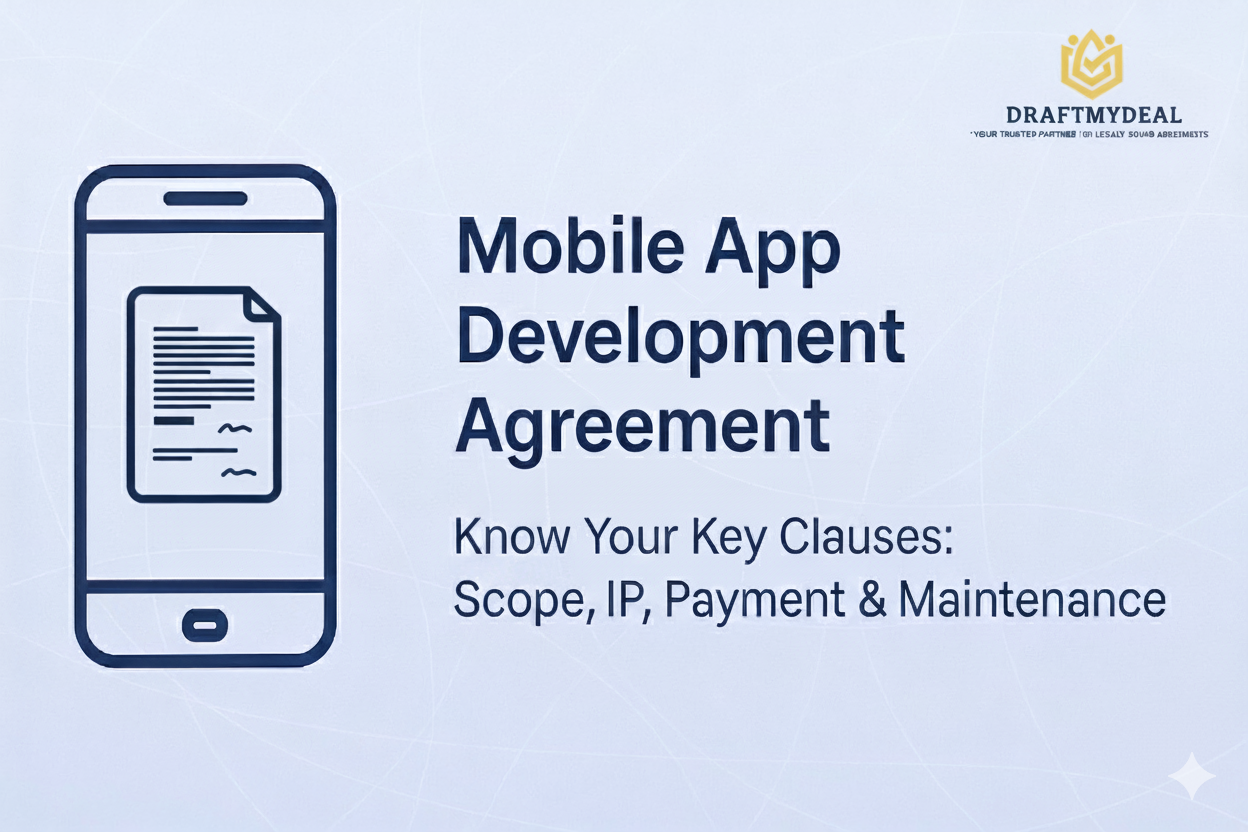
Mobile App Development Agreement – Building Apps with Legal Clarity
In today’s digital economy, businesses across industries are leveraging mobile applications to connect with customers, streamline operations, and expand their digital footprint. However, behind every successful app lies not just great code but also a well-drafted Mobile App Development Agreement—a legal blueprint that defines the rights, responsibilities, and expectations between the client and the developer.
Whether you’re a startup outsourcing your first mobile app or a developer providing professional services, understanding this agreement is critical to avoid disputes, protect intellectual property, and ensure smooth project delivery.
What is a Mobile App Development Agreement?
A Mobile App Development Agreement is a legally binding contract between a client (the business or individual commissioning the app) and a developer (the individual or company creating it).
It outlines the scope of work, payment terms, project milestones, ownership rights, confidentiality obligations, warranties, and dispute resolution mechanisms.
This agreement ensures that both parties are aligned on deliverables, deadlines, and expectations, minimizing misunderstandings during and after the app development process.
Key Clauses in a Mobile App Development Agreement
1. Scope of Work (SOW)
This section defines the nature of the project, including:
-
Type of app (iOS, Android, hybrid, web-based)
-
Features, functionalities, and integrations
-
User interface (UI) and user experience (UX) expectations
-
Third-party APIs or tools to be used
A clear SOW helps avoid “scope creep” — the uncontrolled expansion of project requirements that often leads to delays and disputes.
2. Development Timeline and Milestones
Establishing a timeline with measurable milestones ensures accountability.
Typical milestones may include:
-
Design phase completion
-
Beta version delivery
-
Final testing and launch
Each milestone is often tied to partial payments, creating a fair structure for progress-based compensation.
3. Payment Terms
The agreement should clearly specify:
-
Total project cost or hourly rate
-
Payment schedule (advance, milestone-based, or post-delivery)
-
Reimbursement of additional expenses (e.g., software licenses, hosting)
Defining payment terms upfront ensures transparency and avoids financial disputes later.
4. Intellectual Property (IP) Ownership
This is one of the most critical clauses.
It should specify who owns the source code, design, and final app upon completion and payment.
Common structures include:
-
Work for Hire: The client owns full IP rights after full payment.
-
License Model: The developer retains ownership but grants the client a license to use the app.
Always ensure IP transfer is documented, especially if the app involves proprietary algorithms or brand elements.
5. Confidentiality and Non-Disclosure
Mobile apps often involve sensitive data, business logic, or unique ideas.
A Non-Disclosure Clause ensures both parties protect proprietary and confidential information, even after the project ends.
6. Testing, Acceptance, and Revisions
The agreement should define:
-
The testing process for functionality and bugs
-
The number of revisions or change requests included in the fee
-
The criteria for final acceptance of the app
This helps manage client expectations and developer workload.
7. Maintenance and Support
Post-launch issues are common. The agreement should clarify:
-
Duration and scope of free maintenance (e.g., 30 or 90 days)
-
Fees for ongoing updates or bug fixes
-
Whether future upgrades or platform migrations are included
A maintenance clause ensures long-term app performance and stability.
8. Warranties and Liabilities
Developers typically warrant that:
-
The app is original and doesn’t infringe third-party rights
-
The app will perform as per agreed specifications
However, liability caps and disclaimers protect both parties from excessive claims.
9. Termination and Dispute Resolution
The agreement should specify:
-
Conditions for termination (e.g., breach, delay, or non-payment)
-
Notice period and refund obligations
-
Preferred mode of dispute resolution (arbitration, mediation, or court jurisdiction)
This provides a structured exit in case of disagreements.
Why a Mobile App Development Agreement Matters
A well-drafted agreement:
-
Prevents misunderstandings between clients and developers
-
Safeguards intellectual property and creative rights
-
Ensures timely delivery and quality standards
-
Provides legal remedies in case of disputes
-
Builds trust and professionalism in long-term collaborations
Without such an agreement, both parties risk loss of time, money, and reputation.
Common Mistakes to Avoid
-
Relying only on verbal promises
-
Ignoring IP ownership clauses
-
Not defining revision limits
-
Overlooking data security obligations
-
Failing to mention maintenance and update responsibilities
These oversights often lead to costly disputes that could easily be avoided with a well-structured agreement.
Conclusion
The Mobile App Development Agreement isn’t just paperwork—it’s the foundation of a transparent and successful partnership between clients and developers. It ensures both parties are on the same page from concept to launch and beyond.
If you’re developing or commissioning a mobile app, make sure your agreement is legally robust, tailored to your project, and future-proof.


